Uniform Hieroglyphics
The grass here in North Carolina is crab grass: it’s stiff and prickly against the soles of my bare feet. Anywhere near the coast there’s a good deal of sand intermixed and underneath. When I was a child and visited here in the summers, the grass was not only something I noticed but what I noticed most—not just because it was different than thick, manicured stuff up north—but because when the North Carolina grass was between my toes it was also between my grandfather’s.
Now, like any thousand other mysteries that used to keep my mind feverish, I don’t notice grass very much anymore. The other day a child asked somebody from the Internet: Do people eat grass? The gentleman said no. Then why do we grow it? the child implored, in the way that the children among us not only ask the hard questions but insist upon us having an answer. Recall Walt Whitman: “A child said, what is the grass? fetching it to me with full hands; / How could I answer the child?…. I do not know what it is any more than he.”
I confess I get nostalgic every now and then. Not nostalgic because I think the world was any better when I was four or three or five years old—I just miss the way the world looked when it was still full of wonder. I miss rotary phones and video arcades and animatronic anythings and crappy restaurants with worn-out tablecloths and surcharges for the sharing-of-food.
I miss discovering the neighborhood slowly on bicycles, I miss when the television would simply just turn off in the wee hours because everyone was asleep. I miss the crappy old commercials and their terrible jingles. I miss everything that was lo-def, just as I miss adjusting the tracking on a VCR to get rid of the snow. Or the ritualistic cleaning of a Nintendo cartridge and the specific order of operations to get it working again: blow, insert, hold reset, wiggle the cartridge, power off, press it up and down three times, power on. I miss turning on grandpa’s TV and then reading a book or doing a puzzle or going outside for half an hour while waiting for the tubes to warm.
I don’t really remember learning to read, except that it happened as a result of Mrs. Failey, my first grade teacher. I remember not being able to read, and then I remember being able to read. Once you know how to read you can’t ever look at a word without reading it. And so we endlessly decode, bring to every word we read the history of every association between each word and idea we’ve ever had. This evaluation, or comparison leads to judgment, and when one starts judging, true wonder evaporates into thin air.
In the deepest corner of the William Madison Randall Library, in the circulating oversize section, I discovered a book over the summer session that brought back this sense of wonder and, like a child, I pored over its pages with a sense of awe. The book is one of the strangest books of all time—the Codex Seraphinianus (PN6381 .S4 1983), which was published in 1981 and created by an Italian artist named Luigi Serafini.
I checked the book out and looked it over one Saturday with Ava, my four year old cousin. We debated the possibility that there were trees that can uproot themselves, jump in the water, and swim away. We marveled at hundreds of tiny creatures that interlock to make up rainbows, or laughed at horses with wheels for hind legs. Or people who grow grass out of their palms and have wildflowers creeping from their ears instead of hair. The whole text is written in code: each drawing is explained in some language, somehow, and while it seems to be utterly technical, it can’t be translated or understood.
So far, the only part of the book that’s been explained is the pagination. Some scholars cracked it and realized it’s some sort of base-21, but our understanding of the book stops there. The images are all of things we recognize but changed in a way that is ever so deliciously strange. Young Ava and I couldn’t make heads or tails of it—and really, when it comes down to it, neither of us wanted to. In interviews after many years of silence, Serafini admitted that he wanted to create a work of art that reminded us what it was like to read a book as a pre-literate child, to remind us of the awe we once felt for the world, and to encourage us to find it again.


